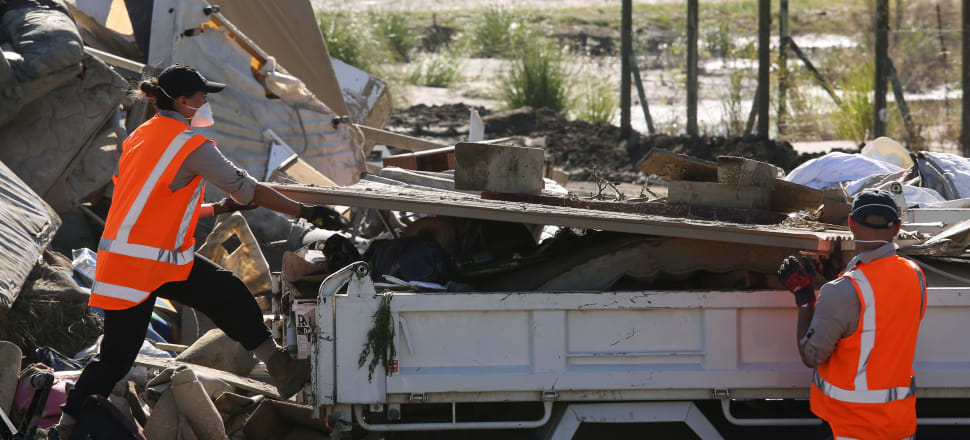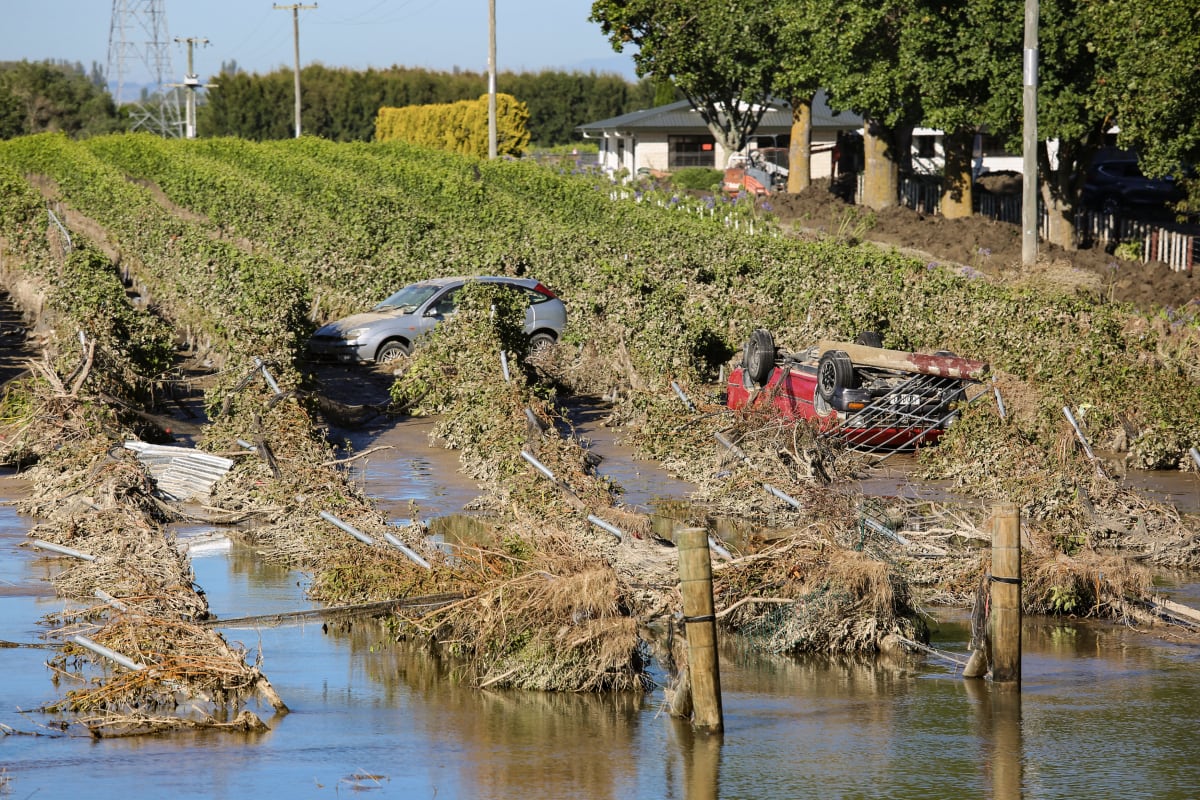
Aged 67, with eyelash extensions and a year of weightlifting under her belt, Lindy Andrews joined Taskforce Kiwi - a volunteer group made up of defence and emergency services veterans - to get stuck in with cyclone relief in Hawkes Bay
Valentine’s Day 2023. It’s one I’ll remember. Not for the wine and roses, but for the hell Gabrielle unleashed.
At 11am, Hawkes Bay Civil Defence Emergency Management issued an immediate evacuation notice cutting a swathe through Napier, from Waiohiki to Anderson Park. I texted friends whose property lies just metres from the breached Tutaekuri River stopbank. "Are you okay?".
Minutes later came the reply. "Need help." Comms were down. They could text, but not dial out. I called Fire and Emergency and gave the operator their address. To reach them would take time, she said. Hundreds of people were in trouble. The NZ Army Unimog finally laboured up their drive at 9.30pm.
Bugger this. I couldn’t sit on my backside and do nothing. As the death toll began to rise and the mud, water and debris gorged on my friends’ home and livelihood, I reached out to a former colleague, one of the many engineers, scientists and disaster risk resilience and recovery experts from whom I’d learned so much by osmosis.
Within hours, aged 67+, with a year of weightlifting under my belt and sporting a ridiculous set of eyelash extensions, I’d joined Taskforce Kiwi. By Saturday I was on the ground in Hastings among a company of strangers - largely defence and emergency services veterans, drawn from across New Zealand. Joining them were four volunteers from Disaster Relief Australia, heading across the Tasman at short notice to help out.
Founder and National Director Richard Adams is no stranger to natural disasters. Born and raised in New Zealand, he served in the British Army, attending the Royal Military Academy Sandhurst and serving in Afghanistan. He left the Army in 2014, moving into emergency management in Victoria, Australia, leading a team of firefighters through the fiery Black Summer of 2019-2020.
He was also a National Director with Disaster Relief Australia, managing their disaster relief teams and leading a team in response to the 2018 Indonesian earthquake and tsunami.

“We ended up working with the Indonesian Board of Emergency Management, providing them with damage assessments that were used to brief the United Nations Secretary-General,” Adams said.
"I ended up as the National Director of Disaster Relief Teams for Disaster Relief Australia before coming home to Christchurch with my young family in 2020."
Despite trying to put disaster work behind him for a while, Adams realised that the veteran-led disaster relief model held promise in New Zealand. In 2021, work began on Taskforce Kiwi, with Adams at the helm and a heavy-hitting board including Bevan Killick, chair of the Defence Employment Support Council, Stephanie Rotarangi, a deputy chief executive with Fire and Emergency New Zealand, and Brigadier Neville Reilly (retired), the former NZ Ambassador to Afghanistan.
Armed forces and emergency services veterans were quick to sign up as volunteers.
Among them was the tiny, tireless machine that is *Debs. She still wears the psychological scars of her time in Afghanistan. In time, I’d learn that the rank smell of decaying sheep carcasses lining Hawkes Bay’s roads triggered flashbacks. Wind up the truck window and move on.
"On the one hand, we’re doing everything we can to help people who need it," Adams said. ‘On the other hand, our volunteers are getting something out of this as well. Taskforce Kiwi renews veterans’ sense of service, purpose and identity. At the same time, they bring enormous experience and add value.’
Taskforce Kiwi’s Hawkes Bay mission is simple - to enable relief operations in Hawkes Bay by supporting local authorities, emergency responders and iwi.
Assembling at Hawkes Bay A&P Showgrounds on Sunday, we found the place heaving with NZ Defence force personnel, Civil Defence volunteers and Emergency Management teams.The air pounded with the ‘thwop, thwop’ of Defence and civilian helicopters. Cue Robin Williams playing US Air Force Sergeant and disc jockey Adrian Cronauer. ‘Gooooood morning Vietnam!’
Taskforce Kiwi volunteers awaited their marching orders, some already hollow-eyed from the previous night’s missing persons search. Forklifts scooted past, laden with everything from toilet paper to baby food, baked beans, noodles, UHT milk and water - bare essentials destined for fractured and cut off communities.
Feeling a tad woozy in the relentless heat I guzzled down a bottle of water laced with electrolytes. First lesson: stay hydrated.
Time to go. I jumped into the truck with Dave, an Army vet with an impressive service record.
Napier’s Life Flight needed a generator and fuel after its overworked and under-capable generator crapped itself. With us towing the fuel and another truck towing a heavyweight generator, we set off.
As we entered the disaster zone, thousands of apples sat wedged in a silt-riddled network of broken fences and debris. Cars and motorhomes, baled hay and building detritus had been tossed into orchards as if by some malevolent hand. Red-stickered buildings were everywhere. Lives, homes, and livelihoods - erased. A few kilometres on, the swathe of devastation was juxtaposed with corridors of normality where people walked and rode their bikes, seemingly without a care in the world.
Meanwhile, other members of our team going door to door undertaking needs assessments and welfare checks were met with relief and gratitude. Our medic, Maia, tended to the unwell.
Gas bottle deliveries, impact assessments, trucking away tonnes of mud-infused furniture and lifetimes of memories, hugs for the hurt and displaced - we worked our way across the Bay until evening.
Delivering a load of essentials to Napier’s Waiohiki Marae hit hard. Silt was piled high, setting cement-hard in the sun, while vast volumes of ponding water drowned both nascent and mature crops. Just a couple of hundred metres away, my friends were doing it tough. We couldn’t reach them.
At the marae, the casualties included newly built papakainga. Whānau waited anxiously to hear whether their homes would be red-stickered, rendering them homeless. A military-style operation ensured that all were fed, watered, and had a roof over their heads.
Downstream, their urupa had been swept away, their tupapaku’s earthly remains cast across paddocks or carried out to sea. The pain was palpable.
Black Power leader Denis O’Reilly extended a welcoming hand, planting a kiss on my cheek. He was doing good work, along with Joe who was desperate to get his hands on personal protective equipment. We gave him what we had and put a call out for more. The road ahead would be long - and bloody tough.
“Many of us lost everything,” Joe told me, “especially those who had the surrounding farms. It’s going to take them a long time to rebuild".
“But amongst all that is hope. The support has been enormous for us, from food to hands on deck. People opening up their homes, people opening up their lives for us.”
With the whānau agreeing that the need at Karamu Marae was much greater, we headed back towards Hastings minus just a few sundry items.
Disaster response and recovery is hard, often dirty work. It’s exhausting, rewarding and at times rawly emotional. At Moteo Marae, Auntie Lexia welcomed us, moving members to tears as she spoke passionately of her whakapapa.
The company of strangers I met on Day One is now a close-knit band of brothers and sisters. Hawkes Bay, we’ve seen you despair, seen you angry, seen you cry. We’ve also seen hope, courage, and tenacity. And we’ve seen you smile. That, our friends, is more than enough reward.







